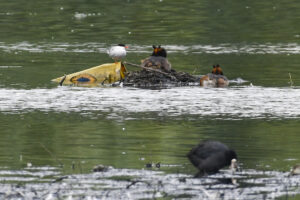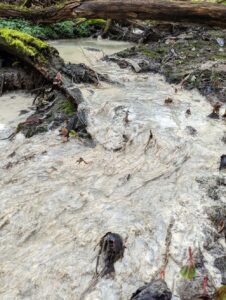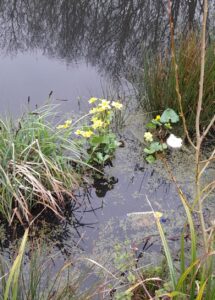Tern rafts, marsh marigolds and mining bees provide an antidote to an otherwise disappointing month at Brent Reservoir (Welsh Harp), writes Ben Watt.

Photo: Magnus Andersson
March. The beginnings of spring. Eyes to the skies for early migrant birds. In the end it is a disappointing month at Brent Reservoir (Welsh Harp). All the action seems to be happening elsewhere. The London Wetland Centre at Barnes gets the first little ringed plover and sand martin. We’re pipped to the post for the first willow warbler by a few days. And the month’s star attraction — a rare influx of alpine swifts — seems to fly over all parts of north London except West Hendon and Neasden.
Is it a sign, I ask Leo, the reservoir’s veteran ornithologist and conservationist. A sign of worsening habitat? Too early to say, he says circumspectly. I still gaze out at the overcast drizzly marshes and can’t help but think of the Harp’s decline since its heyday a few decades ago.
The wetlands were last landscaped in the late 80s. Since then dwindling funding, over-siltation and natural succession allied to increasingly poor water quality and plastic pollution have both damaged the site and been the reason for the formation of our campaign group, and others like us in the area. The ageing Welsh Harp Conservation Group (WHCG) — once a campaigning powerhouse — has had an unexpected revival lately too. Their latest initiative is to get a few grand out of Natural England’s end-of-year slush fund for four new tern rafts — some compensation after owner Canal and River Trust’s aborted funding attempt in 2021.
At its peak forty-four pairs of common tern used to arrive in spring to breed on the expanse of rafts at the Welsh Harp. Last year, due to years of raft dilapidation, only two or three pairs arrived, and the two chicks that were born lacked much protection and were predated. In a last-ditch attempt to keep the terns at the reservoir this summer, two members of the WHCG took a flat-bottomed boat out over six inches of water and treacherous silt, and managed to re-shingle nine of the old rafts and add some new chick-shelters. It was mighty effort in rainswept windy conditions. Ideally, Canal and River Trust would be financially geared up to fufill its SSSI obligations, and the marshes would be dredged, re-profiled and twenty brand spanking new rafts provided from its coffers — terns are mentioned in the SSSI citation after all — but the chances of that currently happening are the same as an alpine swift landing in my garden.
Mid-month, I attend the quarterly meeting of the Welsh Harp Joint Consultative Committee. This is meant to be a forum where local campaigners and stakeholders can question owners and managers face to face and push forward an agenda of improvement. Lately, however, post-pandemic, it has taken place on Zoom. Increasingly there is an air of a school detention about it. Most councillors sit it out, clock-watching. Half of the attendees are rarely up to speed with the agenda. Pallid reports are delivered. A small percentage contribute knowledgably. Any passion is met with online silence. It is bloodless. ‘Death by committee,’ as Feargal Sharkey warned me when I first launched Cool Oak.
In reaction, I despair for a couple of days, then write direct to the top brass at Canal and River Trust, who own the water and shoreline but had sent no one to the meeting, and in whose hands so much of the future health of the reservoir still lies. I get a bright, upbeat response telling me about the ‘challenges’ they face, the unfortunate string of departures from the organisation, and their ongoing exploration of funding opportunities. Reading it, I feel like I’m walking through silt with someone smiling at me. In the meantime, as with every other month recently, I’m told we’re awaiting the publication of the owners’ joint ‘vision’ document — regulars readers must be bored of hearing this — and we’re then meant to, yes, cross our fingers and wait for a lottery charity bail-out.

At the end of month Steve, who has done so much to further volunteer works around the east marsh this winter — and who was on that flat-bottomed boat re-shingling the tern rafts — sends me pictures he’s taken on his circular route around the reservoir that morning. He’s downbeat. The newly polluted outfall on the southern shore that flows direct into the SSSI reservoir — an issue he first raised with the Environment Agency and Brent Council four months ago — is still milky white, putrid and sewage-flecked. As bad as I’ve ever seen it, he says. Hundreds of beer cans litter a wild garlic grove he walks through nearby. A pile of newly-abandoned bicycle frames have been flytipped near the riverbank. Oil and phosphates are still getting through the trash screens.
Is there an upside this month? Yes, apart from the tern rafts, the ebullient Friends of the Welsh Harp finished off their remarkable clearance of the vast plastic flotilla on the Silk Stream last week with zero help from owners; the marsh marigolds replanted as part of the volunteer rare plant re-introduction programme at the Bomb Crater pond last summer are now in flower; and the new sandbank built for mining bees near the bridge has yet to be kicked over and trampled on. This last one counts as a major success story.

*
Ben Watt is a musician and writer, best known as one half of Everything But The Girl. His memoir ‘Romany and Tom’, about his parents, was nominated for the Samuel Johnson (Baillie Gifford) Prize. He runs Buzzin’ Fly Records, and in 2021 founded environmental pressure group Cool Oak.